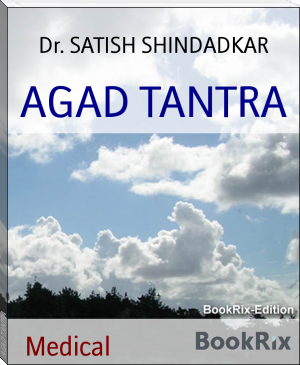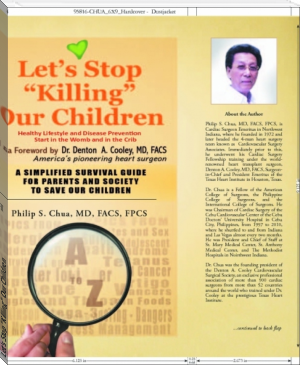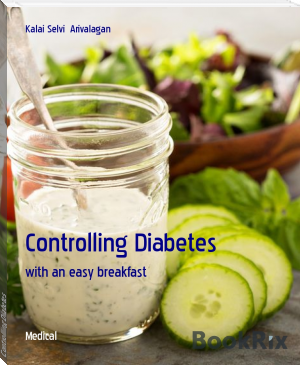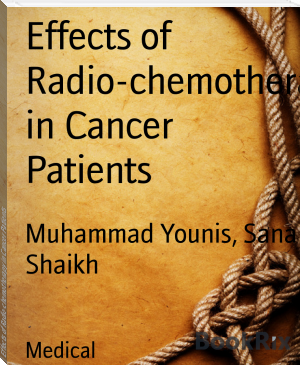AGAD TANTRA, Dr. SATISH SHINDADKAR [web based ebook reader .txt] 📗

- Author: Dr. SATISH SHINDADKAR
Book online «AGAD TANTRA, Dr. SATISH SHINDADKAR [web based ebook reader .txt] 📗». Author Dr. SATISH SHINDADKAR
***
Barbiturates.
Classification : Neurotic cerebral inebriant poison.
Barbiturates are used as sedatives, hypnotics, i.v. anaesthetics & in treatment of strychnine poisoning, epilepsy & psychiatric disorders.
Mechanism of action -
- Depression of CNS, main site of action being mid brain.
- Acts as synergists to analgesics & alcohol.
Signs & symptoms:
Acute poisoning - Giddiness, ataxia, slurred speech, stupor, flaccid limbs, areflexa, diplopia, absent bowel sounds & pupils show alternate constriction & dialatation.
Later, face becomes cyanosed, respiration is slow & there is hypotension, hypothermia, oliguria, albuminuria, bullae or blisters on skin ( barbiturate bullae) & coma.
Chronic poisoning - there is loss of concentration, apathy, vertigo, tremors, ataxia, hallucinations, & barbiturate blisters.
With therapeutic doses there is induction of sleep & sometimes there results mental confusion so that the person takes more drug (barbiturate automatism)
No.
Fatal dose Barbiturates
Duration of action.
Fatal dose
1
Long acting
Sodiumbarbitone
phenobarbitone.
1 to 8-12 hrs.
3-4 gms.
2
Intermediate
Butobarbitone
amylbarbitone
1/2 to 4-8 hrs
2-3 gms.
3
Short acting
Hexabarbitone
pentabarbitone
1/2 to 2-4 hrs.
1-2 gms.
4
Ultrashort acting pentothal
for duration of anaesthesia
1 gm.
Fatal period
1-2 days.
Treatment :
- Gastric lavage
- Use of enema & purgatives.
- Maintainance of respiration by raising foot end, suction of airway, artificial respiration & oxygenation, endotracheal intubation if needed.
- CNS stimulants can be used.
- Antibiotics for prophylaxis
- Diuretics.
- Peritoneal & hemodialysis if required.
- Rest symptomatic treatment should be done.
P.M. appearances:
- Features of asphyxia or comato asphyxia.
- Cyanosis.
- Froath at nose & mouth.
- Bronchopneumonia & pulmonary oedema
- Congestion of abdominal viscera.
Medicolegal importance:
- Suicidal poisoning is common.
- Accidental poisoning is used from overdose.
- It is a drug of addiction.
- Ultra short acting barbiturates alone or in combination with morphine & scopolamine are used as truth serum.
***
Cocaine
Classification : Neurotic cerebral deleriant poison
Its synthetic substituents - Novacaine, Nupercaine, xylocaine (used for local anaesthesia)
Cocaine is obtained from leaves of Erythroxylon coca.
Fatal dose : 1 gm.
Fatal period : 2 hrs.
Signs & symptoms :
Acute poisoning - initially it acts as stimulant & then depressant of CNS.
Chronic poisoning (Cocainism, Cocainophagia, Cocainomania)
Initially there is unstable nervous system.
- Tongue & teeth becomes black.
- Anorexia, weightloss, weakness, tremors, impotence, mental illness.
- Magnam symptom (feeling of grains of sands lying underskin)
cocain bugs ( feeling of small insects creeping on the skin)
Treatment :
- Stomach wash if poison is ingested.
Antidote - Amyl nitrate inhalation
- Symptomatic treatment.
Post mortem findings:
Features of asphyxia or cardiac failure.
Medicolegal importance:
- Poisoning is mostly accidental.
- Is a drug of addiction.
- Applied on sexual parts to increase the time of act.
- Is a common drug of abuse in sports.
***
9. श्वासावरोधी विष (Respiratory poisons)
Carbon monoxide (CO)
Classification : Respiratory poison / asphyxiant.
It is colourless, odourless, tasteless, non irritating gas burns with blue flame. It is present in coal gas, all burning devices, mines, exhaust gas of vehicles etc.
Fatal dose & fatal period.
CO concentration in atmosphere
Time required for death
0.01 %
Safe
0.1 %
2-3 hrs.
1 %
15-20 mins.
7-10%
2-5 mins.
Mechanism of action :
CO has 200-300 times greater afinity for haemoglobin than oxygen & therefore it produces COHb, hence reducing the oxygen content of blood & tissues. Thus it acts as chemical asphyxiant.
- CO also exerts direct toxic effects by binding to cellular cytochromes.
Signs & Symptoms : Severity of poisoning depends upon the percentage of COHb present in blood.
Chronic poisoning : Nausea, Gastric trouble, dyspnea, palpitation, gradually increasing CNS damage.
Treatment :
- Fresh air rest.
- Artificial respiration & oxygenation if needed.
- Respiratory stimulants.
- Blood transfusion if required.
- IV mannitol & dextrose.
Post mortem findings -
- Skin is bright cherry red.
- Froath at nose & mouth.
- All viscera & blood are cherry red.
- Haemmorrhages in GIT, lungs, heart & brain.
- Oedema of lungs & brain.
No.
% of COHb in blood
Signs & symptoms
1
0-10%
No specific
2
10-20%
Breathlessness, headache, flushed skin
3
20-30%
above symptoms and throbbing
headache, buzzing in ears, muscles
weakness & inco-ordination, dyspnoea
4
30-40%
above symptoms & dizziness, nausea,
vomitting, collapse, loss of memory
mental confusion, diminution of vision
5
40-50%
Above symptoms strength is increased &
staggering, palpitation, retinal haemmorhages
6
50-70%
above symptoms & asphyxial convulsions
coma, respiratory paralysis & death
7
above 70 %
Respiratory arrest & death.
Medicolegal importance -
Poisoning is usually accidental.
***
Carbon dioxide (CO2)
Classification : Respiratory poison / asphyxiant.
This is heavy, colourless, odourless, poisonous gas; normally atmospheric air contains 0.4 % of CO2.
Fatal dose & period :
Concentration in atmosphere upto 60-80 % may cause rapid death.
Minimum fatal conc. is 25-30 %
Mechanism of action :
Acts as asphyxiants.
P.M. Findings :-
Signs of asphyxia.
Medicolegal importance -
Poisoning is usually accidental.
Signs & symptoms
Conc. of CO2 in atmosphere
Symptoms
Upto 2 %
increased in rate & depth of respiration
Upto 5 %
Laboured breathing
Upto 20 %
Respiratory difficulty
Upto 40 %
Dyspnoea, discomfort, muscle weakness, hypotension
Upto 50 %
Dyspnoea, tinitus, fullness in head, drowsiness, unconsciousness, coma
60 to 80 %
Immidiate unconsciousness & rapid death
100 %
Spasm of glottis, vagal inhibition & sudden death
Treatment
Symptomatic treatment
Hydrogen sulphide (H2S)
Classification: Respiratory poison / asphyxiant.
It is a colourless, transparent gas with smell of rotten eggs.
Fatal dose & period:
In presence of anoxia 100 p.p.m. may prove fatal in few minutes.
Concentration above 500 p.p.m. causes death in 30-60 min.
Mechanism of action:
It acts as a local irritant & also causes both anoxic effects & damage to the cells of the CNS by direct action.
Signs and symptoms:
It enters the body by inhalation route only. In lesser concentration - conjuctivitis, irritation of respiratory tracts, drowsiness and death may occur during sleep.
In less concentration - giddiness, nausea, abdominal pain, laboured breathing, arrhythmias, delerium, convulsions, coma, death (due to asphyxia).
If pure hydrogen sulphide is inhaled death occurs almost from paralysis of respiratory centre.
Chronic poisoning: Irritation of eyes & photophobia, irritation of nose & throat, headache, dizziness, weakness, colic, nausea, vomitting diarrhoea, bronchitis, bronchopneumonia, confusion or excitement & insomnia.
Treatment -
- Fresh air rest.
- Artificial respiration & oxygenation if required.
- Respiratory stimulants.
- Symptomatic treatment.
If patient survive for first 4 hrs recoveries is assured.
P.M. findings:-
- Signs of asphyxia.
- Smell of gas.
- P.M. staining is bluish green & tendency to rapid putrefaction or decomposition.
- If death is delayed pulmonary oedema & congestion of lungs are found.
In some cases, organs are dark brown.
Medicolegal importance -
Poisoning is usually accidental.
***
10 इतर विष (Miscelleneous)
Radioactive Substances.
Radioactivity may be defined as the decomposition of an atom accompanied by the emission of radient energy such as alpha, beta or gamma rays.
They have therapeutic as well as destructive properties.
They are destructive to living cells and especially to those which are rapidly proliferating, such as, bone marrow, lymphoid tissue, intestinal epithelium and cells of reproductive organs.
Thorium, uranium, radium and their salts emit radiant energy and are therefore known as radioactive substances. They are exceedingly poisonous.
Radioactive isotopes emit the same radiations as radioactive elements and the dangers in their use are also simillar.
The unit of dose, that is the amount or quantity of radiation, is measured in terms of energy absorbed in the tissues.
The SI units of radiation are Gray ( gy) and Sievert (Sv).
The average natural background radiation to which we are exposed is about 0.9 milligray per year.
Fatal dose - high dose 5-10 Sv and above
Fatal period - Kills within wks.
Signs and symptoms:
These may be delayed for years or come suddenly depending upon the amount of radiation and duration of its exposure. Effects are cumulative.
Therapeutic exposure of the body to irradiation causes little general upset or occasionally a sickness known as the radiation sickness. (nausea, loss of appetite, mild fever and malaise)
Excessive exposure may lead to dermatitis, radium burns and skin cancer.
Damage associated with X-rays and radium include early megaloblastic erythropoesis and terminal aplastic anaemia, leucocyte abnormalities including leucopenia, intestinal ulceration, diarrhoea and tissue fibrosis including pulmonary fibrosis.
Chronic exposure, is characterised by shortening of life span (premature ageing), thrombocytopenia and anaemia, general cachexia, hypertension and cataracts. The incidence of pneumonia and leukemia is high. Genetic defects, sterility, jaw necrosis also occur.
The effects of exposure to a single large dose of radiation is known as acute radiation syndrome. ( nausea, vomitting, diarrhoea, prostration, mild fall in B.P.)
On ingestion of radioactive substances, all above symptoms can occur, other symptoms include general weakness, progressive anaemia and pathological changes in bones.
Treatment :
- No specific antidotes.
- Clothes are removed and body is washed with soap and water.
- Blood or bone marrow transfusion should be given if blood picture so indicates.
- Antibiotics for prevention of secondary infections.
- Fluid electrolyte imbalance must be treated.
- The rest symptomatic treatment.
P.M.
All the soft tissues, organs and mainly bones show the presence of radioactive material.
***
Hallucinogens
Classification : Miscellaneous poison.
Hallucinogens are drugs which produce altered states of consciousness. As they cause sensations of unreality they are known as hallucinogens or psychedelics.
e.g. LSD, Peyote, mescalin, alcohol, cannabis, cocaine.
Some are described in earlier chapters.
LSD - Lysergic acid diethylamide :
It is synthesized from rye ergot. It is tasteless, odourless & most potent hallucinogen.
Fatal dose - no deaths reported.
Signs & symptoms :
Hilarity, emotional swings, dialated pupils, tremors, insomnia, vertigo, headache.
It may damage brain cells permanently chromosomal damage may occur, also there is damage to foetus.
Anxiety, panic depressive & paranoid reaction, mood changes, confusion, psychotic reaction.
Treatment :
Symptomatic.
psychotherapy may be useful.
Medicolegal importance :
It is a non addictive but habituating drug.
***
Stimulants
Classification : Miscellaneous poison.
They stimulate CNS resulting in diminution of sense of fatigue & increase in mental alertness, followed by depression.
e.g. Amphetamine. (Benzidrine)
dexamphetamine ( Dexedrine)
Fatal dose : 200 mg.
Fatal period : 5-6 days.
Signs & symptoms :
In very severe poisoning - Convulsions & deep unconsciousness.
In large doses - delerium & hallucinations.
In mild cases - excitement, talkativeness, restlessness, irritability, tremors, dry mouth, nausea, vomitting, abdominal cramps, diarrhoea, palpitation, and tachycardia.
In chronic poisoning - amphetamine psychosis resembling acute paranoid schizophrenia.
Treatment :
- Put the patients in dark room
- Gastric lavage & Sedatives.
P.M. Findings :
- Reddish patches on skin.
- Oedema of lungs and Pulmonary petechinal haemmorrhage.
Medicolegal aspects :
- Poisoning may be suicidal or accidental.
- Misused by sportsmens or students frequently,
- Leads to addiction.
***
Antihistamines.
Classification : Miscellaneous poison.
Commonly used preperations are antistine, histanine, chlorpheniramine, Diphenhydramine, promethazine etc.
Fatal dose : 1 gm.
Fatal period : uncertain.
Signs & symptoms :
- Dryness of mouth, nausea, vomitting, drowsiness, headache, blurred vision, retention of urine & nervousness.
- In large doses - fixed dialated pupils, disorientation, hyperreflexia, tremors, nystagmus, convulsions.
Treatment :
Gastric lavage
Diazepam i.v.
Symptomatic treatment.
P.M. Findings : Signs of asphyxia.
Medicolegal importance : Accidental poisoning.
***
Parthenium Hysterophorus
वर्गीकरण - स्थावर वनस्पतीज विष
Also known as Congress grass, carrot grass, altamisa, bitter weed, star weed, white top, wild feverfew, chatak chandani, ramphool, garghas, Scourge of India.
Parthenium has been declared noxious in America, Australia, India and many other countries especially those having tropical climates.
The presence of Parthenium in cropped lands results in yield reduction up to 40 %. It is also responsible for bitter milk disease in livestock fed on grass mixed with Parthenium.
विषाक्त अंग – पंचांग
Medicinal uses :
The word Parthenium is derived from the Latin word ‘parthenic’, suggesting medicinal uses.
To treat fever, diarrhoeas, neurologic disorders, urinary tract infections, dysentery, malaria and it is used by some tribes as remedy for inflammation, eczema, skin rashes, herpes, rheumatic pain, cold, heart trouble and gynaecological disorders.
Parthenium Hysterophorus has been found to be pharmacologically active as analgesic in muscular rheumatism, beneficial for neuralgia. The methanol extract of the flowers showed significant anti-tumour activity and cytotoxic properties against T cell leukaemia, HL-60 and cancer cell lines.
Sign and symptons:
It is a poisonous, allergic and aggressive weed whose pollens float in air and cause skin inflammation (eczema), asthma (especially in children and elderly people), dermatitis, hay fever (kalazar) etc. in human beings. It is a major cause of Allergic Sinusitis, breathlessness and other respiratory problems, black spots, burning and blisters around eyes, diarrhoea, affecting about 10 % of the people who live near it.
The weed also causes dermatitis in animals like cows and goats. When they eat the weed, their milk becomes bitter; also it reduces yield of milk and weight of animals.
Toxins :
All part of the plant contains toxins called sesquiterpene lactones (SQL). Other toxic compounds are hysterin, ambrosin, flavonoids such as quercelagetin 3,7 - dimethylether, 6-hydroxyl kaempferol 3-0 arabinoglucoside, fumaric acid. Parahydroxy benzoin and vanillic acid, caffeic acid, p courmaric, anisic acid, p-anisic acid, chlorogenic acid, ferulic acid,





Comments (0)